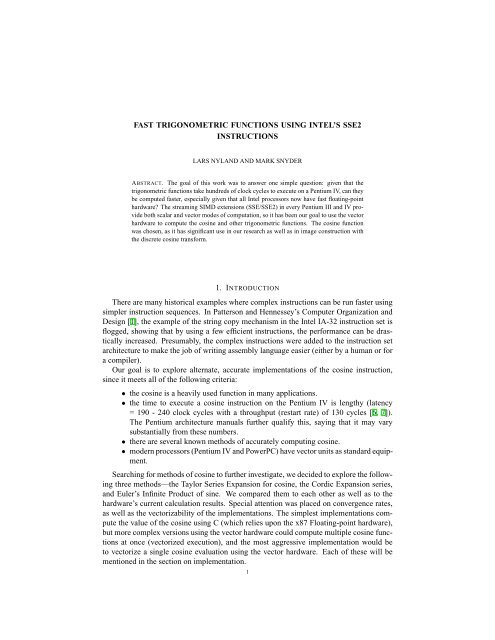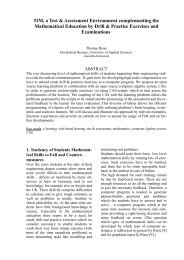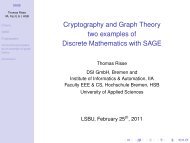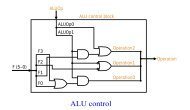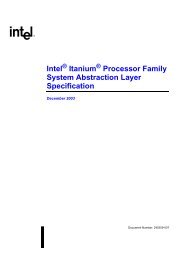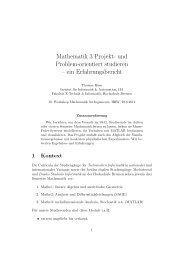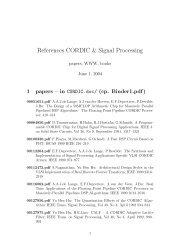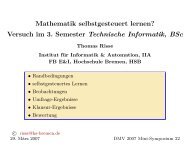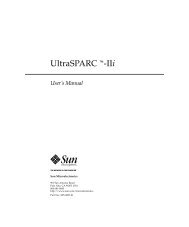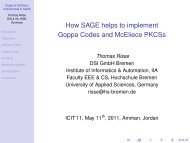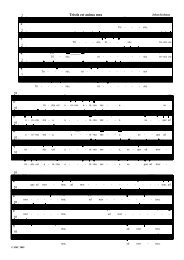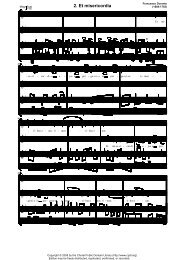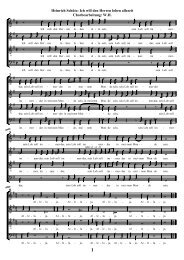FAST TRIGONOMETRIC FUNCTIONS USING INTEL'S SSE2 ...
FAST TRIGONOMETRIC FUNCTIONS USING INTEL'S SSE2 ...
FAST TRIGONOMETRIC FUNCTIONS USING INTEL'S SSE2 ...
Create successful ePaper yourself
Turn your PDF publications into a flip-book with our unique Google optimized e-Paper software.
<strong>FAST</strong> <strong>TRIGONOMETRIC</strong> <strong>FUNCTIONS</strong> <strong>USING</strong> INTEL’S <strong>SSE2</strong><br />
INSTRUCTIONS<br />
LARS NYLAND AND MARK SNYDER<br />
ABSTRACT. The goal of this work was to answer one simple question: given that the<br />
trigonometric functions take hundreds of clock cycles to execute on a Pentium IV, can they<br />
be computed faster, especially given that all Intel processors now have fast floating-point<br />
hardware The streaming SIMD extensions (SSE/<strong>SSE2</strong>) in every Pentium III and IV provide<br />
both scalar and vector modes of computation, so it has been our goal to use the vector<br />
hardware to compute the cosine and other trigonometric functions. The cosine function<br />
was chosen, as it has significant use in our research as well as in image construction with<br />
the discrete cosine transform.<br />
1. INTRODUCTION<br />
There are many historical examples where complex instructions can be run faster using<br />
simpler instruction sequences. In Patterson and Hennessey’s Computer Organization and<br />
Design [1], the example of the string copy mechanism in the Intel IA-32 instruction set is<br />
flogged, showing that by using a few efficient instructions, the performance can be drastically<br />
increased. Presumably, the complex instructions were added to the instruction set<br />
architecture to make the job of writing assembly language easier (either by a human or for<br />
a compiler).<br />
Our goal is to explore alternate, accurate implementations of the cosine instruction,<br />
since it meets all of the following criteria:<br />
• the cosine is a heavily used function in many applications.<br />
• the time to execute a cosine instruction on the Pentium IV is lengthy (latency<br />
= 190 - 240 clock cycles with a throughput (restart rate) of 130 cycles [6, 7]).<br />
The Pentium architecture manuals further qualify this, saying that it may vary<br />
substantially from these numbers.<br />
• there are several known methods of accurately computing cosine.<br />
• modern processors (Pentium IV and PowerPC) have vector units as standard equipment.<br />
Searching for methods of cosine to further investigate, we decided to explore the following<br />
three methods—the Taylor Series Expansion for cosine, the Cordic Expansion series,<br />
and Euler’s Infinite Product of sine. We compared them to each other as well as to the<br />
hardware’s current calculation results. Special attention was placed on convergence rates,<br />
as well as the vectorizability of the implementations. The simplest implementations compute<br />
the value of the cosine using C (which relies upon the x87 Floating-point hardware),<br />
but more complex versions using the vector hardware could compute multiple cosine functions<br />
at once (vectorized execution), and the most aggressive implementation would be<br />
to vectorize a single cosine evaluation using the vector hardware. Each of these will be<br />
mentioned in the section on implementation.<br />
1
2 LARS NYLAND AND MARK SNYDER<br />
1.1. Selecting Methods of Calculation. The methods we chose to investigate are all series,<br />
either adding on terms that gradually approach zero, or multiplying terms that gravitate<br />
towards a value of one. Initially, we implemented them in a higher-level language,<br />
tracking the number of terms needed for each version to be accurate within one unit in the<br />
last place. Also considered was the cost of adding each term in to the result. We assume<br />
for all of these that x has the range −π/2 < x < π/2, as all other values of cos(x) can be<br />
determined from this range.<br />
1.2. The Cordic Expansion of Cosine. The CORDIC calculations involve rotation of an<br />
arbitrary vector by known angles, in either a positive or negative direction [2]. The angles<br />
are initially large, and are reduced in half with each iteration. A typical set of rotation<br />
angles is a multiple of the series {1, 1/2, 1/4, 1/8, 1/16, . . . }. The angle of rotation is<br />
specified, and then a running tally of the arctangent of the rotation angles is kept.<br />
To compute a cosine (or sine), a unit vector along the x-axis is rotated by the known<br />
angles in either a positive or negative direction with smaller and smaller steps until the desired<br />
accuracy is achieved. For example, to compute cos(π/3) and sin(π/3), the following<br />
iterative calculation is performed:<br />
[cos(π/3), sin(π/3)] = f(f(f(f(f([1, 0], −π/4), π/8), −π/16), π/32), −π/64)<br />
where f is a rotation of a vector by a specified angle. The choice of whether the rotation<br />
is positive or negative is determined from a running sum of angles. When the sum exceeds<br />
the desired angle, the rotation reverses until the sum is once again less than the desired<br />
angle. This is in contrast to the normal sort of binary choice process that either includes or<br />
ignores a contribution.<br />
We can perform this algorithm through a simple for-loop, with initial conditions z 0 = x,<br />
x 0 = 1, y 0 = 0, and tables of constants for 2 −i values and for tan −1 2 −i values (arrays<br />
t1 and t2, respectively):<br />
for(i = 0; i < numbits; i++)<br />
{<br />
d = (z
<strong>FAST</strong> <strong>TRIGONOMETRIC</strong> <strong>FUNCTIONS</strong> <strong>USING</strong> INTEL’S <strong>SSE2</strong> INSTRUCTIONS 3<br />
multiple of π (including zero), that the terms approach the value one. This is shown in<br />
figure 1 where the number of terms required is small where cos(x) = 0.<br />
Euler’s infinite product is an interesting formulation, as it is a product rather than a sum,<br />
and the terms approach 1. This means that the bulk of the information is in the first few<br />
terms. We’ll see how this affects the accuracy of a truncated form (finite expansion) in the<br />
section on convergence.<br />
1.4. The Taylor Series Expansion for Cosine. Finally, the most widely known expansion<br />
of the cosine function is the Taylor Series Expansion (technically, the Maclaurin series),<br />
which is:<br />
cos(x) = 1 − x2<br />
2! + x4<br />
4! − x6<br />
6! + x8<br />
8! − . . .<br />
If x < 1, it is obvious that the terms in the sequence rapidly decrease. Indeed, even<br />
when x > 1, there is a point where x n < n!, and from that point on, the terms in the series<br />
rapidly diminish. Given that the domain of interest for x is −π/2 < x < π/2, the only<br />
term that can ever be larger than 1 is x 2 /2, which can be as large as π 2 /4 (approx. 2.5).<br />
After that, the terms rapidly diminish in value.<br />
2. CONVERGENCE AND ACCURACY<br />
2.1. Cost of Calculation and Convergence. There are two main aspects of the cost of<br />
calculating cos(x). The first is the number of terms required to achieve the desired accuracy,<br />
and the second is the cost of calculating each term. In this section, we examine<br />
both for each expansion introduced above. One example where the cost per term is high<br />
is Ramanujan’s method for calculating π [4]. The benefit is that the number of digits is<br />
doubled for each term, so just about any constant cost will outperform most other methods<br />
for finding π.<br />
The first step in choosing an expansion of cosine to implement is to see how many terms<br />
are required to obtain a desired accuracy. The next section examines how much work is<br />
required per term; knowing both the convergence and work per term, we can finally choose<br />
an expansion for implementation.<br />
Our accuracy goal is to match IEEE 754 single and double precision floating-point<br />
numbers. These have 24 and 53 bits in the significand, which represent roughly 7 and 16<br />
decimal digits of precision (we strive to reduce error to be less than within 10 −7 or 10 −16 ,<br />
respectively).<br />
Figure 2 shows the convergence properties for each of the expansions for a variety of<br />
angles. The Taylor Series expansion has much higher accuracy than the other two, and in<br />
fact, it takes a significant number of terms to achieve even the slightest bit of accuracy for<br />
Euler’s Infinite Product.<br />
2.2. CORDIC. The CORDIC method gains one bit of precision per iteration of the loop;<br />
so that means either twenty-four or fifty-three iterations. Unrolling the loop into pairs of<br />
iterations, the last three lines could be removed, and thus requiring five multiplications<br />
and three add/subtracts per bit calculation. Since we see in figure 1 that Taylor requires<br />
significantly fewer terms and note that it is less costly per term, CORDIC is not going to<br />
be as efficient as the Taylor series expansion.<br />
2.3. Euler’s Method. Euler’s method, although an accurate series, converges painfully<br />
slowly—note in figure 1 how many hundreds of terms are required to gain even merely<br />
three digits of precision. Infinite products seem unsuited for approximations.
4 LARS NYLAND AND MARK SNYDER<br />
Number of terms<br />
14<br />
12<br />
10<br />
8<br />
6<br />
4<br />
2<br />
Taylor Series<br />
−90 −45 0 45 90<br />
Angle<br />
Cordic Approximation<br />
60<br />
50<br />
40<br />
30<br />
20<br />
10<br />
−90 −45 0 45 90<br />
Angle<br />
Euler’s Infinite Expansion<br />
400<br />
300<br />
200<br />
100<br />
−90 −45 0 45 90<br />
Angle<br />
FIGURE 1. These graphs show how many terms are required to obtain<br />
accuracy comparable to IEEE 754 Floating-Point (single and double<br />
precision for computing cos(x)). The Taylor series requires more terms<br />
as x moves away from 0, while the Cordic expansion is not dependent<br />
on the value of x, and appears to achieve precision with the number of<br />
terms that match the number of bits in IEEE single and double precision<br />
floating-point numbers (24 and 53 bits). Euler’s infinite expansion<br />
is far worse. The two traces in the rightmost graph are for 2 and 3-digit<br />
precision, as the convergence rate of Euler’s infinite product is nearly<br />
zero.<br />
Error<br />
10 5 Taylor Series<br />
10 0<br />
10 −5<br />
10 −10<br />
10 −15<br />
10 −20<br />
0 5 10 15 20<br />
10 5 Cordic Series<br />
10 0<br />
10 −5<br />
10 −10<br />
10 −15<br />
10 −20<br />
0 20 40 60<br />
Euler’s Infinite Series<br />
5<br />
10<br />
10 0<br />
10 −5<br />
10 −10<br />
10 −15<br />
10 −20<br />
0 20 40 60<br />
FIGURE 2. Convergence. A graph demonstrating the convergence of<br />
different series as terms are added. Each graph shows the reduction in<br />
error as the number of terms is increased. Different values of x are used<br />
to demonstrate the dependence of convergence on the input value. The<br />
values chosen here are 0, 15, 30, 45, 60, 75, and 90 degrees. The Taylor<br />
series converges rapidly, yielding multiple digits per term. The Cordic<br />
series yields one bit per term. Euler’s infinite series converges surprisingly<br />
slowly.<br />
2.4. Taylor Series. As each term is increased (e.g., from x 6 /6!, say, to x 8 /8!), each additional<br />
x must be divided by each additional factor (e.g., 8!/6! = 7 ∗ 8) in the factorial<br />
expansion, and multiplied by the calculated x 2 value. Yet accuracy is completely lost if x n<br />
and n! are computed prior to division. To avoid redundant calculations, the equation can<br />
be even more organized, as follows:<br />
( ( ( ( ( )))))<br />
1 1 1 1 1<br />
cos(x) = 1 − x 2 ·<br />
2! − x2 ·<br />
4! − x2 ·<br />
6! − x2 ·<br />
8! − x2 ·<br />
10!
<strong>FAST</strong> <strong>TRIGONOMETRIC</strong> <strong>FUNCTIONS</strong> <strong>USING</strong> INTEL’S <strong>SSE2</strong> INSTRUCTIONS 5<br />
This form is commonly called Horner’s Rule [5]. Storing these inverse factorial constants<br />
to a table t1 (including the terms’ signs, too), we reduce the problem to the following:<br />
t = [1/(2!), 1/(4!), 1/(6!), 1/(8!), 1/(10!)];<br />
cosx = 1 − x 2 · (t<br />
0 − x 2 · (t<br />
1 − x 2 · (t<br />
2 − x 2 · (t<br />
3 − x 2 · (t 4 ) ))))<br />
3. METHODOLOGY/IMPLEMENTATION<br />
Note: The UNIX program ’Better Calculator’ (’bc’) was used to check accuracy, since<br />
it offers an arbitrary number of digits of precision.<br />
3.1. Taylor Series, In C. This version requires only one multiplication and one addition<br />
per term. While this is very attractive, due to the nesting of calculations, we cannot use<br />
the vector hardware to compute multiple terms at once, since every single instruction is<br />
dependent on the previous. What could be done in the aggressive approach of calculating<br />
one value by vector math<br />
Vectorized calculation of four single-precision terms at once has quite a bit of overhead.<br />
We take one x value and then calculate x 2 , x 4 , x 6 , and x 8 , then pack them into one register<br />
as a = [1|x 2 |x 4 |x 6 ], and another register as b = [x 8 |x 8 |x 8 |x 8 ]—then we can create the<br />
next four terms’ x-dependent portions with a = a · b = ([1|x 2 |x 4 |x 6 ] · [x 8 |x 8 |x 8 |x 8 ] =<br />
[x 8 |x 10 |x 12 |x 14 ]). These registers are packed with a few calls to the shufps instruction,<br />
which is as fast as multiplication (it shifts portions of 128-bit registers around). Storing the<br />
packed constants is handy, at least—we simply have the 32-bit constants stored contiguously<br />
in memory, and load 128 bits at a time. Yet, building up our packed registers leads<br />
to much overhead, and only saves three multiplications and three add/subtracts: the number<br />
of terms necessary determines whether this is more efficient— as we see in figure 1,<br />
only seven terms are required for single-precision, meaning only two batches of four terms<br />
are needed—and indeed, the overhead completely overwhelms the advantage of vectorized<br />
calculation of one series’ terms. Had we required, say, hundreds of terms, each batch afterwards<br />
would require an add, a load, and two multiplies (versus four loads, four adds,<br />
and four multiplies for four terms in the scalar implementation). In short, a nested version<br />
leads to less overhead calculation, and is more efficient.<br />
3.1.1. An Initial Experiment. We took the factorized version of the Taylor series and implemented<br />
it in C. The routine is shown in figure 3, and demonstrates the calculations<br />
required to bring the value of the angle, x, into the range of −π/2 < x < π/2. The coding<br />
style shows a method of essentially avoiding an if-else statement using array indexing. The<br />
original if-else code was similar to:<br />
x = x % pi;<br />
x = abs(x);<br />
if (x > pi/2)<br />
x = pi - x;<br />
else<br />
x = 0 - x;<br />
...<br />
Instead, we always perform the subtraction, using one bit of the quadrant number as an<br />
index to an array that contains [0, π]. For the case when x < π/2, we execute x = 0 − x =<br />
−x. This is fine, as cos(−x) = cos(x). Now we have the angle (less than π/2) whose
6 LARS NYLAND AND MARK SNYDER<br />
extern double ifact[]; // an array with 1/n!, 0 >1)&1] - x; //explained in detail below ()<br />
x2 = - (x*x);<br />
r = ifact[i] * x2;<br />
}<br />
for (i -= 2; i > 0; i-=2){<br />
r += ifact[i];<br />
r *= x2;<br />
}<br />
r += 1;<br />
return r;<br />
FIGURE 3. A C version of the factorization of the Taylor series that<br />
yields one add and multiply per term in the series. Prior to the for-loop,<br />
the code is bringing the value of x into the range −π/2 < x < π/2.<br />
Additionally, we need to determine if cos(x) will be negative. This is<br />
done by computing the quadrant number, in the conventional sense, and<br />
then realizing that quadrants 2 and 3 share a 1-bit in the second bit. We<br />
use that bit as an index to perform the subtraction of x = π − x if x<br />
is in quadrants 2 or 3, and x = 0 − x when x is in quadrants 1 or 4.<br />
The subtraction is always performed, eliminating the need for a branch,<br />
allowing the code to be pipelined in a straightforward manner. This loop<br />
could be unrolled or put in a switch statement, eliminating the loop overhead<br />
and further improving performance. Since the integer ‘quadrant’<br />
initially equals either 0, 1, 2, or 3, and is incremented by one to 1, 2, 3,<br />
or 4, we can shift the binary representations [0001, 0010, 0011, 0100] to<br />
the right by one bit to [0000, 0001, 0001, 0010], then AND them with a<br />
one to get [0000, 0001, 0001, 0000]; thus, we have obtained a ‘zero’ for<br />
the first and fourth quadrants, and a ‘one’ for the second and third quadrants.<br />
magnitude will match the requested angle. This gives us is a fully pipelinable execution<br />
stream, as no branches are executed.<br />
Another discovery in this implementation is the accuracy with which the inverse factorials<br />
can be stored. One feature of floating-point numbers is that the density increases
<strong>FAST</strong> <strong>TRIGONOMETRIC</strong> <strong>FUNCTIONS</strong> <strong>USING</strong> INTEL’S <strong>SSE2</strong> INSTRUCTIONS 7<br />
Quadrant image<br />
FIGURE 4. We take note of the bottom two bits of the integer acquired<br />
between conversions; this two-bit number, being one of {00, 01, 10, 11},<br />
represents the 1st, 2nd, 3rd, and 4th quadrants. We can AND with 0x1<br />
to get {00, 01, 00, 01}, obtaining ‘0’ when in quadrants one and three<br />
and ‘1’ when in quadrants two and four. In the figure above, notice<br />
that the angles 30, 150, 210, and 330 degrees have identical magnitudes,<br />
yet in quadrants two and four, we would need the value [quadrantSize<br />
- portionInTheQuadrant] instead of simply [portionInTheQuadrant]. If<br />
we convert this number back to a floating-point number, we can multiply<br />
it by π/2, getting either zero or π/2—call this value xpartial.<br />
dramatically as the values approach zero (to a point), so the inverse factorials are accurately<br />
stored. The factorial values, however, would not be accurately stored once they<br />
grow beyond a particular size.<br />
3.1.2. Performance in C. The performance of our C version is notably better than the<br />
hardware version of cosine. On a Pentium IV, a loop of ten million iterations adding up<br />
cosine values took 0.998 seconds with our version and 1.462 seconds using the hardware<br />
instruction. The summation required 0.242 seconds, so the performance comparison is<br />
ours 1.462 − 0.242<br />
=<br />
theirs 0.998 − 0.242 = 1.614<br />
So simply writing cosine as a series calculation, stopping at the full accuracy of double<br />
precision numbers, we can outperform the hardware by over 60%. Recall that this implementation<br />
uses the IA-32 instruction set, so all floating-point calculations are performed<br />
using the x87 floating-point hardware, not the <strong>SSE2</strong> hardware.<br />
3.2. ASM Implementation with <strong>SSE2</strong> Instructions.<br />
3.2.1. Sign Bits. The first action is masking off the sign bit because we want truncation<br />
to lessen the magnitude always; cos(x) = cos(−x), so this is safe. In order to discern<br />
to which quadrant the input value belongs, we first calculate x 0 · 2/π (pseudo-modulardivision—2/π<br />
is a stored constant). Then, we truncate by converting that to an integer,<br />
reconverting back to floating-point. We decide whether to subtract that truncated value<br />
from π/2 or zero as described with the figure 4. We subtract, getting x partial −(x 0·2/π) =<br />
x ready . Now we have the correct magnitude for cosine calculations. Since the first thing we<br />
do with this adjusted x-value is square it, it doesn’t even matter that cos(−x) = cos(x)—<br />
thinking more generally, this is acceptable for other functions like sine (though we’d add<br />
1 to the integer before the AND instruction, to get a 1 when in the 2nd and 3rd quadrants<br />
instead).<br />
3.2.2. Determining the Quadrant of x. In addition, we need to adjust the sign of the result<br />
at the end. Since we collapsed the four quadrants into one range, we take the integer<br />
from between conversions again from our example, and create either a negative or positive<br />
zero—by adding 1, shifting right one bit, shifting left 31 bits 1 . This will be negative only<br />
for the second and third quadrants, which need a change in sign. Then the result can be<br />
1 To understand what the modifications did, remember that it was an integer of the number of quadrants;<br />
disregarding the upper 30 bits for now, note that the bottom two signify in which quadrant our initial x value<br />
is (adding ‘1’ changes them from [00,01,10,11] to [01,10,11,100]). Shifting those binary numbers right one bit
8 LARS NYLAND AND MARK SNYDER<br />
XOR’d with our calculated magnitude, and if the initial x value was in the second or third<br />
quadrant, this XOR operation will change only the sign bit, leaving the entire rest of the<br />
number alone.<br />
3.2.3. All that is left to do is make the x 2 value and work through the terms. We load<br />
the smallest term’s constant and then repeatedly multiply-by-x 2 and add-the-next-constant,<br />
XORing the sign adjustment after all terms’ calculations.<br />
3.2.4. Double Precision. Making a version for double-precision cosine calculation is nearly<br />
identical; the only two changes are: (a) we must have more terms, and (b) when we mask<br />
the sign, we have to load only the top 32 bits, AND them with the mask, and return them<br />
so that we can then load the entire 64 bits together.<br />
As was mentioned before, an aggressive approach of calculating multiple terms with<br />
the vector-hardware is unsuited; even for doubles, we don’t require nearly enough terms<br />
for the vectorization to even match computation time. However, this is a separate problem<br />
from vectorization for calculating two or four cosines at once, which is quite applicable.<br />
3.3. Vectorized cosine. For more mathematically oriented programs, it is not at all uncommon<br />
to have large sets of data requiring computations on an entire set. A version of<br />
cosine has been made that takes an input array, an output array, and an integer (indicating<br />
the number of cosines to be performed) as parameters. One constraint that had to be overcome<br />
was that although we may load 128 bits from memory not on a 16-byte boundary,<br />
we may not store it off of 16-byte boundaries. So the single-precision function does the<br />
following:<br />
(1) check that a positive number of calculations is requested<br />
(2) compute individual cosines until the address lines up to a 16-byte boundary<br />
(3) compute as many groups of four cosines as remain requested<br />
(4) individually compute any remaining cosines.<br />
3.3.1. Step (1) is merely a safeguard against looping endlessly on towards negative infinity,<br />
should meaningless input be received; step (2) is necessary, because on rare occasions<br />
someone might request storage to begin not on a 16-byte boundary, even though compilers<br />
attempt to line arrays up on larger boundaries. Step (3) does the majority of the calculations.<br />
Step (4) cannot just grab 128 bits, calculate away, and then store only the requested<br />
values. This could conceivably attempt to access memory not allocated to the program;<br />
compilers actually try to leave in extra space to align arrays to 16-byte boundaries when<br />
they can, but this safeguard is necessary.<br />
3.3.2. The vectorized version is more efficient in two main ways—obviously, it gets to<br />
calculate four cosines at a time (other than a possible and negligible few at either end).<br />
But also, imagine the difference between calling any one function a multitude of times<br />
versus calling a vectorized version of the same purpose. All the pushing and popping of<br />
parameter values on the stack while leaving and returning from every single call adds up<br />
significantly, and the vectorized version bypasses basically all of those calls. Other benefits<br />
arise with other functions that require identical preparation prior to calculation— the<br />
method of rounding must be specified for some of the packed conversion instructions (we<br />
were using truncation), and it only needs to be done once, meaning even less instructions<br />
[0,1,1,0] changes the bottom bit to a ‘1’ for the second and third quadrant, and a ‘0’ for the first and fourth quadrant.<br />
Then, shifting thirty-one bits to the left (which is why we ignored all the upper bits), we have constructed<br />
the zero with the appropriate sign, since quadrants two and three have negative cosine values [0x80000000 versus<br />
0x00000000].
<strong>FAST</strong> <strong>TRIGONOMETRIC</strong> <strong>FUNCTIONS</strong> <strong>USING</strong> INTEL’S <strong>SSE2</strong> INSTRUCTIONS 9<br />
function hardware (s) per call (ns) new (s) per call (ns) hw / new percentage<br />
cosf 1.2184 107.8390 0.7074 56.7357 1.9007 190%<br />
sinf 0.9601 82.0035 0.5145 37.4456 2.1899 219%<br />
tanf 1.5203 150.5690 1.0194 100.4800 1.4985 149%<br />
cos 2.0213 200.792 2.2998 228.641 0.8782 87%<br />
sin 1.6809 166.765 2.2799 226.656 0.7357 74%<br />
tan 1.9974 198.410 3.0979 308.455 0.6432 64%<br />
vcosf 0.1099 95.3170 0.0434 28.8220 3.3070 330%<br />
vsinf 0.0909 76.3410 0.0146 14.5850 5.2340 523%<br />
vtanf 0.1196 105.0010 0.0918 91.7760 1.1440 114.4%<br />
vcos 0.1594 159.3970 0.0772 77.1600 2.0658 206%<br />
vsin 0.1293 129.3330 0.0396 39.6230 3.2641 326%<br />
vtan 0.1374 137.3690 0.0753 75.2870 1.8246 182%<br />
expf 5.0331 501.974 3.3309 331.759 1.5135 151%<br />
TABLE 1. Comparison of the original C-library versions to our own.<br />
than a packed version of the function (i.e., a function for calculating exactly four values at<br />
once).<br />
3.4. Double Precision Cosine. A double-precision floating-point vectorized cosine function<br />
was also made which differs only in that: (a) groups of two values are calculated in<br />
the vectorized portion of the process, and (b) more terms were necessary.<br />
4. PERFORMANCE RESULTS<br />
We implemented the above versions, also adding sine and tangent (each using Taylor<br />
Series). On a 2.80 GHz Pentium IV processor, ten million calculations were performed<br />
for each non-vectorized example (1,000,000 for the vectorized versions), and calculation<br />
time due to looping was accounted for and removed. Due to the variable length of completion<br />
times, these percentage values actually fluctuate significantly, on the order of about<br />
30%. Individual test cases of the ten millions (for scalar) and millions (for vectorized) of<br />
calculations are given here.<br />
We operate nearly twice as fast as the hardware for scalar single-precision numbers, for<br />
sine and cosine. Tangent is faster by about 50%, though that can dip to as low as only about<br />
20% faster in specific trials. Incidentally, the double-precision versions for cosine, sine,<br />
and tangent were as accurate—yet they were no more efficient than the hardware. Further<br />
tests to find and eliminate the limiting steps of these functions are under way.<br />
All of our vectorized versions were faster. Vectorized tangent has a slight gain for<br />
single-precision (perhaps insignificant over the scalar version) and around an 80% increase<br />
in the double-precision version. Sine and Cosine showed the absolute most improvement<br />
in vectorized form, though—operating 2 and 3.2 times faster than double-precision calculations,<br />
and operating 3.3 and 5.2 times faster than regular single-precision calculations.<br />
We see that this method of calculations is not just another 5% optimization; the significant<br />
increase in efficiency merits serious checks into the feasibility of integration into<br />
already complete programs, as well as into works still un-begun.
10 LARS NYLAND AND MARK SNYDER<br />
5. OTHER APPLICATIONS<br />
This generalized method of taking Taylor Series expansions, discovering how many<br />
terms are necessary, and creating a Horner factorization with stored constants can be extended<br />
to some other functions.<br />
5.1. Sine. Of course sine may be calculated, nearly identically to cosine; with sine, we actually<br />
took enough terms to calculate values up to π instead of π/2, as this further reduced<br />
the overhead and setup. This is because we now have only two halves of the unit circle<br />
to deal with, instead of four quadrants, and we get to simply shift the integer of number<br />
of halves up 31 bits with no modification. A single multiplication could be gained also by<br />
changing all of the terms to include a π 2n /2 2n for the nth term, and removing an earlier<br />
multiplication by π/2.<br />
5.2. Tangent. Tangent is not as obedient. Its Taylor Series contains constants of 1/3, 1/5,<br />
1/7, and so on, instead of some version of inverse factorials. As a result, it converges much<br />
too slowly; however, the simple fact that tan(x)=sin(x)/cos(x) is quite handy. We may<br />
either calculate both sine and cosine and divide, or get craftier. Based on the quadrant in<br />
which we find the value, we can do the following, recalling that sin 2 (x) + cos 2 (x) = 1:<br />
√<br />
• calculate sine, and then cos(x) = 1 − sin 2 (x). Divide.<br />
• calculate cosine, then sin(x) = √ 1 − cos 2 (x). Divide.<br />
We choose which to use based on which provides better accuracy—first and third quadrants,<br />
we’ll calculate cosine; for second and fourth, sine (accuracy changes based on using<br />
a very small value or a close-to-one value in division). Division is not nearly as fast as<br />
multiplication; for single- and double-precision, it takes 23 or 38 clock cycles for scalar<br />
computations, respectively, and 39 or 69 cycles for packed computations, respectively (see<br />
Intel Pentium 4 [6] and Intel Xeon Processor Optimization [7]). Square Root is the same.<br />
Unfortunately, calling divide and square root after calculating the sine or cosine tends to<br />
kill the efficiency. Results that are just as accurate as the hardware have been obtained, but<br />
they are not yet quicker.<br />
5.3. Exponential Function. Even a non-cyclic function such as exponential can be computed<br />
this way. Its Series is:<br />
e x = ∑ x k<br />
k!<br />
k=1<br />
(This is the sum of the absolute value of all the terms in both sine’s and cosine’s series).<br />
The catch for this function is that we will need increasingly more terms to add up to the<br />
escalatingly large values to be returned. Fortunately, we can implement a little trick:<br />
e x/2 · e x/2 = e x/2+x/2 = e x<br />
If we multiply the input by 1/2 n and then square the result n times, we can bypass the<br />
large values. We could compute e x/2 once and square it, or compute e (x/4) and square<br />
it twice, and so on. This comes at a price, though—despite floating-point numbers being<br />
happily denser nearer to zero, we will eventually be losing accuracy by the final squarings;<br />
it turns out that initially multiplying by 1/16 or 1/32 worked best. Since even floatingpoint<br />
can only store a number but so large, this scheme can accommodate large enough<br />
values until infinity would have to be returned anyways. Alternatively, for e x for extremely
<strong>FAST</strong> <strong>TRIGONOMETRIC</strong> <strong>FUNCTIONS</strong> <strong>USING</strong> INTEL’S <strong>SSE2</strong> INSTRUCTIONS 11<br />
negative values, we get values until our number of digits of accuracy are being surpassed<br />
by the smallness of the answer to return, and zero is returned.<br />
5.4. Inverse Trigonometric Functions. Arc-functions are also possible, though they do<br />
not have as convenient Taylor Series—theirs are slow, like tangent’s Taylor Series. Preliminary<br />
study shows satisfactory accuracy for single-precision versions of arccosine and<br />
arcsine, and a search for the most useful method of obtaining arctangent and for versions<br />
returning a double-precision answer are under way.<br />
6. CONCLUSION<br />
We have shown that utilizing Taylor Series can improve the time necessary for computing<br />
basic functions such as sine and cosine; it gives accurate results as well, for some<br />
other functions such as exponential, tangent, arcsine, and arccosine. Vectorized versions<br />
of these functions give highly improved function speed, often more than tripling the speed.<br />
The generalized method described can be implemented in other limited applications, as<br />
well. Creating a library of these functions could offer a very integratable solution to the<br />
implementation.<br />
REFERENCES<br />
[1] David Patterson and John Hennessey. Computer Organization and Design: The Hardware/Software Interface.<br />
Morgan Kaufmann, 2nd edition, 1997.<br />
[2] Ray Andraka. A survey of CORDIC algorithms for FPGAs. In FPGA’98, the proceedings of the ACM/SIGDA<br />
sixth international symposium on Field Programmable Gate Arrays, pages 191–200, 1998.<br />
[3] Thomas J. Osler and Michael Wilhelm. Variations on vietas and wallis’s products for pi. Mathematics and<br />
Computer Education, 35:225–232, 2001.<br />
[4] John Bohr. Ramanujan’s method of approximating pi, 1998.<br />
[5] Donald E. Knuth. The Art of Computer Programming, v.2, Semi-numerical Algorithms. Addison-Wesley, 2nd<br />
edition, 1998.<br />
[6] Intel Corporation. Intel Pentium 4. 2002.<br />
[7] Intel Corporation. Intel Xeon Processor Optimization. 2002.


